Islamic Art Exhibition in London
A new exhibition of Islamic art from across the Muslim world aims to do far more than unite unusual, luxurious and rarely-seen objects.Organisers of the London event say that they hope the illuminated Korans, the perfume bottle carved from rock crystal and the leaf skeleton decorated with sacred text will change the way people think about Islam.
The Blue Koran: one of the most sumptuous examples of the text. A page from the luxurious 'Blue Koran', made in North Africa, and dating from the 10th Century.
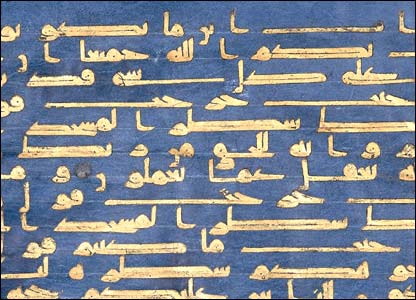
The fabric of the Mongol robe was embellished with designs in gold. The top section of a robe from the Mongol period with very long sleeves and intricate buttons.
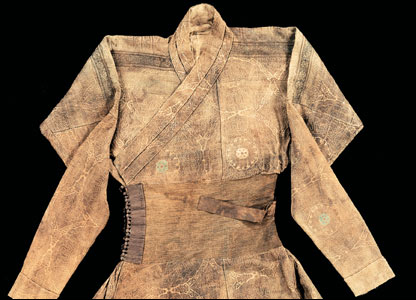
The Aga Khan, leader of the world's 15 million Ismaili Shia Muslims and organiser of the project, believes arts can become "a medium of discourse that transcends barriers".
"The essential problem, as I see it, in relations between the Muslim world and the West is a clash of ignorance," he said in a recent speech.
He hopes the objects will spark a cultural dialogue and increase understanding about Islam within the West.
Alnoor Merchant, the keeper of the collection at London's Ismaili Centre, points to a slim column of white marble slowly rotating in a glass case. On one side are flowers, sculpted out of the stone in the Roman era. On the other, an Arabic script records the details of the life and death of a North African leather merchant. An architectural fragment has thus been transformed into a tombstone, re-used and re-interpreted centuries later.
"Islam is falsely represented in some contexts," Mr Merchant says. "This exhibition seeks to show that Islam has a heritage that is a shared legacy - it is not about killing and suicide bombings."
Many objects reveal these cross-cultural linkages and histories of rulers of different faiths who admired and respected each others traditions, he adds.
The 165 objects on display form part of a broader collection which will open at the Aga Khan Museum in the Canadian city of Toronto, in 2010.
They include a page from one of the world's most sumptuous Korans, the "Blue Koran", whose gold script stands out against a deep indigo parchment.
The North African Koran's pages were dyed with lapis lazuli.
"It was made in imitation of the precious Christian Byzantine texts and documents printed on purple parchment," Mr Merchant says.
Flowering trees
Other texts on display include a single page from a vast Koran whose pages stretch 2m (6.5ft) in height and a scroll the width of a palm with a microscopic text probably painted with a single-haired brush.
Organisers also hope the exhibition will also break stereotypes about Islam as an austere faith.
Among the exhibits is a miniature of a poet, many highly decorated musical instruments and countless paintings of princes hunting and scholars dancing.
There are also images of people playing backgammon and musical instruments in gardens with flowering trees. And tucked into a corner of one of the cabinets is an image showing a young couple framed in gold foliage. But look closely and you will see that the young woman is administering brand marks on her partner's arm as a test of the sincerity of his love.
"Music was an integral part of our culture," Mr Merchant says. "The notion that music was not allowed is a fallacy. Music and gamesmanship were a part of normal life."
The Spirit & Life exhibition, Masterpieces of Islamic Art from the Aga Khan Museum Collection, is on display at London's Ismaili Centre until 31 August 2007.
A folio from the Akhlaq-i Nasiri, a philosophical treatise written by one of Iran's greatest medieval intellects, Nasir al-Din Tusi.
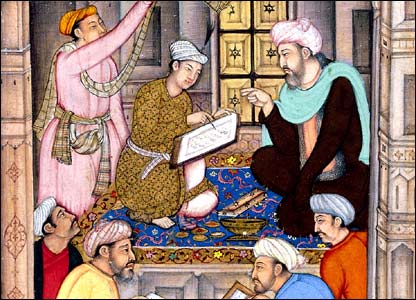
A detail from probably the earliest manuscript of part of the Canon of Medicine, one of the most influential texts in the history of medicine.
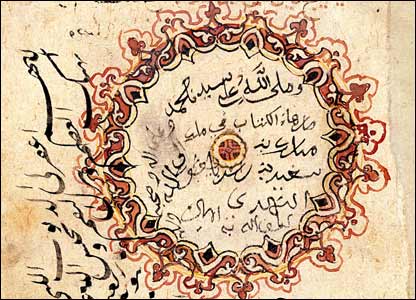
A bird-shaped medieval bronze incense burner. The perfumed smoke would come out of small holes in the container.
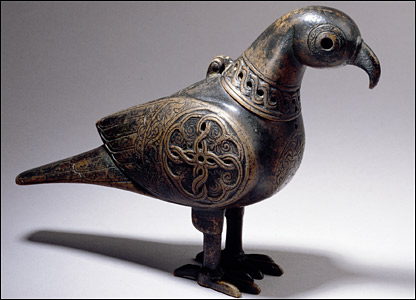
An Iranian glazed dish with the inscription: "Generosity is a disposition of the dwellers of paradise."
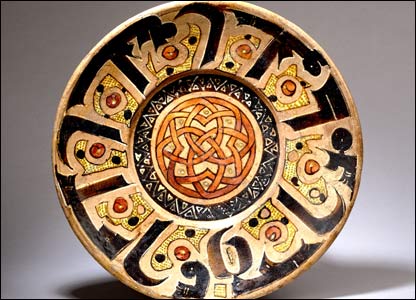
A detail from the Shahnama, a manuscript made for a Persian ruler and decorated with 258 miniatures in gold and inks.
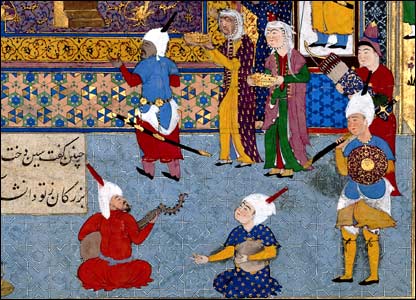
Subscribe to:
Post Comments
(
Atom
)



No comments :
Post a Comment